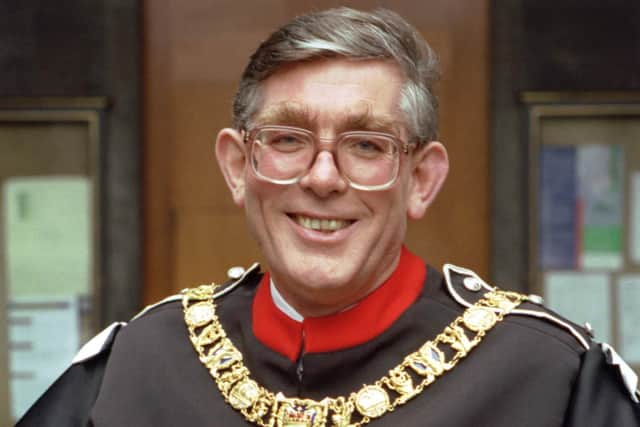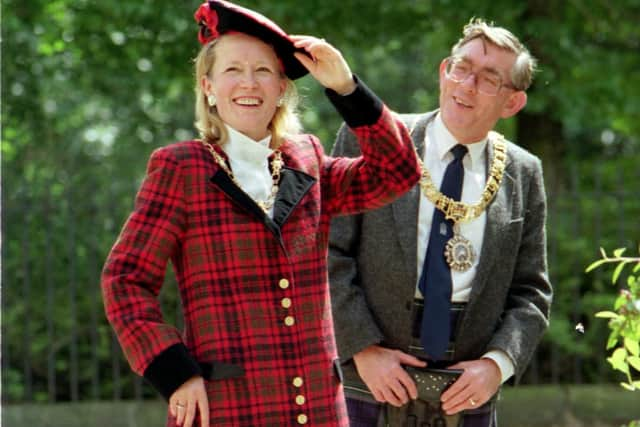Scotsman Obituaries: Norman Irons, first SNP Lord Provost of Edinburgh and diplomat


There can’t be many Lord Provosts who have abseiled down Edinburgh City Chambers or led a kilted conga down the Royal Mile.
But Norman Irons was game for anything if it would help a good cause.
Advertisement
Hide AdAdvertisement
Hide AdHis dance down the Capital’s historic thoroughfare, accompanied by the pipes and drums of the Scots Guards, launched the Cancer Relief Macmillan Mile Challenge fundraiser. His descent down the city council’s headquarters promoted a campaign for the High Blood Pressure Foundation – raising his own considerably as he launched himself down the building in less than two minutes. It also earned the city’s first SNP civic head the nickname “Natman”.


Norman MacFarlane Irons was born in Glasgow but moved to Edinburgh with his parents Dugald and Anne when he was three months old. Educated at George Heriot’s School, where he would later serve on the Board of Governors, he qualified as a chartered engineer after studying in London and Edinburgh.
He began his career with international engineering consultancy Steensen Varming Mulcahy Partnership which, in the 1970s, worked on the Sydney Opera House.
In 1983, along with a colleague, he set up his own practice, Irons Foulner Consulting Engineers, where he continued to work during his time as Lord Provost.
Having joined the SNP in the early 1970s, he was elected councillor for the Drumbrae/Northeast Corstorphine ward of Edinburgh District Council in a 1976 by-election, a shock result as the SNP was then a minority party. Then, in 1987, he stood as an MP in the marginal Edinburgh West constituency but trailed fourth to the sitting member, James Douglas-Hamilton.
As a councillor he represented his ward for two decades, becoming the city’s first SNP Lord Provost in 1992.
At that year’s election the controlling Labour administration lost three seats, falling two short of the 32 councillors needed to control the council. Irons approached the Labour group with an extraordinary offer: he and his fellow SNP councillor Derek Williams would support the Labour Group in policy votes in return for Irons being made Lord Provost and Williams being given a convenorship.
The deal was eventually agreed and it became Irons’ proudest moment. It also brought with it duties as Lord Lieutenant and although he thoroughly enjoyed hosting royalty and international heads of state he was equally at home in the company of Edinburgh residents.
Advertisement
Hide AdAdvertisement
Hide AdA tireless worker, he would get up at the crack of dawn and head to the office of his own firm to do some work before his official car whisked him off to an engagement, writing or finessing his own speeches en route.
On Christmas Day he would visit retired servicemen, care homes and parents with newborn babies in hospital. And when he heard that an elderly postcard seller, Harry Tranter, had been missing from his trading spot on Waverley Bridge for some weeks, he tracked down his address and invited him to the City Chambers for a drink.
“We met the great and the grand, yes,” he said, “but we were privileged to meet the less fortunate. We never distinguished between the gilt-edged invitation card and, say, a simple letter from a schoolteacher asking if we could fit in a visit.”
He served as a councillor and, latterly, Lord Provost until 1996, supported by his wife Anne, whom he met when they were both teenagers and with whom he had a daughter and son.
A respected ambassador for the city, a few years after leaving office he was appointed consul for Denmark, recommended by Queen Elizabeth II’s former press secretary Michael Shea and Baron Steel of Aikwood, David Steel the former Liberal Party leader. He went on serve as Consul for Hungary and was Dean of the Consular Corps of Scotland.
“His commitment extended beyond borders,” said Christoph Crepaz, current Dean of the Consular Corps in Scotland. “His warmth, wisdom, and willingness to collaborate were instrumental in creating a vibrant and supportive diplomatic community.”
Made a CBE in the 1995 New Year’s Honours, he had honorary doctorates from Edinburgh’s Napier and Heriot-Watt Universities and was an honorary Fellow of the Royal College of Surgeons.
His consular worked earned him Commander with Star Royal Norwegian Order of Merit, Knight’s Cross of the Order of Merit of Hungary and Commander of the Royal Order of Dannebrog.
Advertisement
Hide AdAdvertisement
Hide AdHe was also a director of the Edinburgh International Festival Society, the Royal Edinburgh Military Tattoo and Edinburgh’s Dynamic Earth and Capital Theatre.
On the Board of Edinburgh’s St Giles’ Cathedral Renewal Appeal Trust until his death, he attended services there every Sunday wearing his trademark kilt.
His main leisure interest was rugby – he was a member of Heriot’s Rugby Club and had been a member, player and president of Lismore Rugby Club. He also loved reading, particularly political biographies, until restricted by Parkinson’s disease.
Diagnosed with the condition in 2015, he remained stoic and, in a typically generous gesture, donated his brain to a tissue bank at Imperial College London for research, in the hope that others might not suffer the cruelty of the disease.
Norman Irons is survived by his wife Anne, daughter Elizabeth and son Kenneth.
Obituaries
If you would like to submit an obituary (800-1000 words preferred, with jpeg image), or have a suggestion for a subject, contact [email protected]